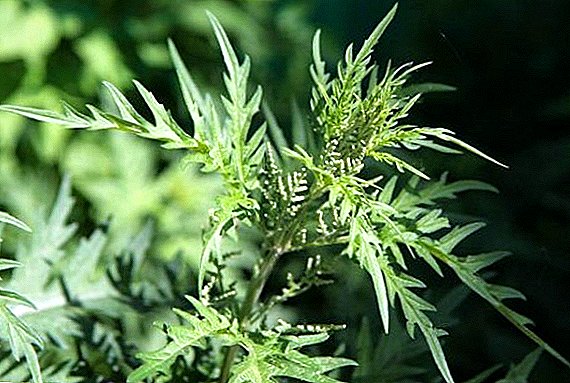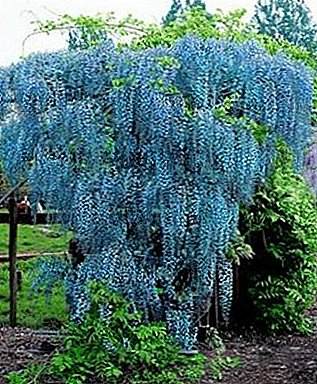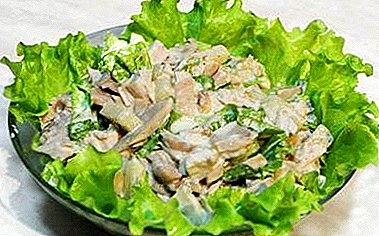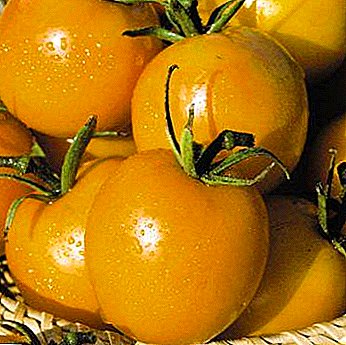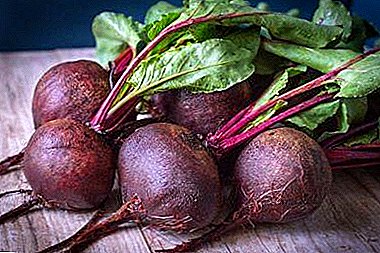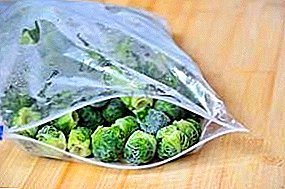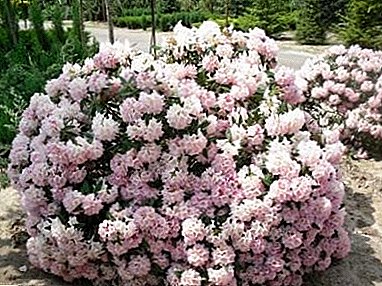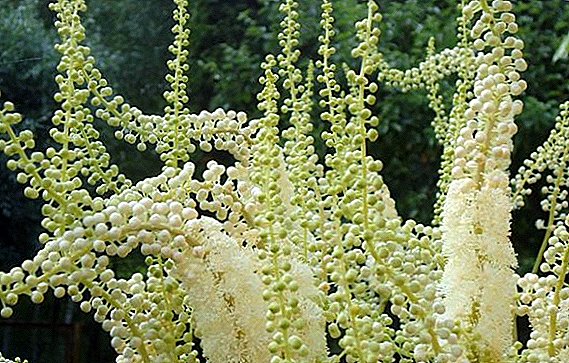 Despite the unpresentable name, Klopogon is a very beautiful herbaceous plant that will not only beautify any summer cottage, but also will do the owner good service as a medicinal raw material, as well as a wonderful way to scare away the many pests of the garden.
Despite the unpresentable name, Klopogon is a very beautiful herbaceous plant that will not only beautify any summer cottage, but also will do the owner good service as a medicinal raw material, as well as a wonderful way to scare away the many pests of the garden.
Description and biological features
The plant has many names - in addition to black cohosh or сimicifuga in Latin (both literally means “dispelling bugs”), it is also known as black cohosh, black cohosh and black snake root. The very beautiful name of this perennial is silver candles, it is much more suited to the quivering light purple, pink or white peduncles, proudly rising upwards like candles on an expensive candelabrum. The bush of black cohosh also looks very elegant and unusual, and its cultivation is not associated with special troubles. Tsimitsifuga is a member of the buttercup family and is represented by more than one and a half dozen different species with a huge habitat zone. North America is considered the birthplace of the plant, but it also grows over vast areas of predominantly the eastern part of the globe (the territory of China, Japan, eastern Asia and the Far Eastern forests).
Like black cohope, the Buttercup family includes aquilegia, hellebore, bathing vessel, basil, anemone.Delicate openwork leaves, beautiful flowers, unpretentiousness and a great ability to fit into any landscape composition - what reason do you need to get this amazing plant at your dacha?
Did you know? The healing properties of black cohosh humankind noticed many centuries ago. The natives of North America who knew nature well have long since used this plant to combat a multitude of ailments, and in China it is still taken for toothache, as well as for various female diseases.The black shrimp bush, depending on growing conditions and formation, can be half the height of human growth or much higher (up to two meters) and consist of one or a couple of stems with numerous large dark leaves growing directly from the ground, slightly in shape parsley
 The roots are very strong, which is not surprising, given the not very favorable conditions in which the cimicifuga is forced to survive in natural conditions, when the cold gives way to heat, and the showers - to drought. The height of the peduncles corresponds to the height of the bush, the number of flowers on a single inflorescence, in the form of a brush or cylinder, ranges from three to a dozen.
The roots are very strong, which is not surprising, given the not very favorable conditions in which the cimicifuga is forced to survive in natural conditions, when the cold gives way to heat, and the showers - to drought. The height of the peduncles corresponds to the height of the bush, the number of flowers on a single inflorescence, in the form of a brush or cylinder, ranges from three to a dozen.Various species of black cohosh bloom from mid-July until autumn, this period in the life of the plant lasts quite long, sometimes up to one and a half months, which, of course, is an added bonus for summer residents. But the non-flowering cimicifuga looks quite attractive.
Important! Growing up in a wooded area, Klopogon is sufficiently susceptible to strong and penetrating winds, therefore, if your site is on high ground and actively blown, it is better to protect quivering “silver candles” by surrounding them with higher plants, for example, trees or buildings.
Choosing a place to grow
Tsimitsifuga quite easily adapts and adapts to external conditions, including humidity and lighting, so choosing a place for its planting is easy, you just need to take into account that once planted snake root shrub can exist for a quarter of a century, from this point of view the landscape with the participation of this plant should be thought out in advance, especially since the snake root does not like transplants.  Klopogon in general tolerates both brightly lit areas and a completely shaded place in the garden (the second option is even more preferable, since it looks more like the natural habitats of this perennial).
Klopogon in general tolerates both brightly lit areas and a completely shaded place in the garden (the second option is even more preferable, since it looks more like the natural habitats of this perennial).
Regarding the soil, zimicifuga is unpretentious, but prefers a nutrient loose soil with deep processing and the absence of moisture stagnation.
Did you know? The black cohope planted from seeds does not bloom for the first two years, which is another drawback of this breeding method.
Planting and breeding black cohosh
Klopogon is a plant that involves both seed and vegetative reproduction, however, in any case, the land should be prepared very carefully before planting, because, as already mentioned, the plant should not be moved from place to place. In addition to deep digging, it is recommended to immediately add a standard amount of organic matter (for example, humus or peat), some sand and mineral dressings. 
Growing from seed
Experienced gardeners know how difficult it is to grow black cohosh from seeds. The problem is that the seeds of this plant lose their germination very quickly, so you need to use only fresh material, and, therefore, sowing in open ground next spring is not the best option.
Winter sowing also gives not very good results, because for optimum germination the seeds initially require intensive heat, and in our conditions in the open field it cannot be ensured.
Learn how to grow Turkish carnation, geyheru, castor bean, plumeria, pansies, mimulyus, shtokrozu, osteospermum, and cynia from seeds.So, the only way - sowing in seedlings in a warm room. The seeds will germinate for up to six months, the first half of this period must be at least + 20 ° C for the surrounding air, then you can make it a little cooler, but still not lower than + 16 ° C.
Important! Creating seeds of the greenhouse effect when planting in seedlings should not be too high humidity affects germination!In the spring, after the final establishment of a high temperature and exclusion of the probability of night frosts, seedlings can be transplanted in open ground. Even full compliance with the technology does not provide sustainable seedlings, so often in order to achieve results during the winter several times it is necessary to carry out pilling.

Dividing bush
For this method of vegetative propagation, an approximately five-year-old adult bush is ideally suited. The procedure is carried out in the offseason - best of all in early spring, so that the young plant has managed to gain a foothold, and the maternal one - to survive stress, however, autumn “execution” is allowed, but it should be done as early as possible, in late August-early September, so that winter frosts do not ruin all work.
Important! Reproduction of cimicifuga by dividing a bush is not only a much simpler way compared to seed, but also an opportunity to stimulate the mother bush to more intensive growth!The shrub is carefully removed from the ground, then it is necessary to separate the buds with processes with a sharp shears, then return the adult bush to its former place, and keep the shoots in a stimulating solution and plant in a container for better rooting and subsequent transplantation, or immediately into the open ground with a mandatory shading (a young plant does not tolerate the drying out of the soil, which often occurs in an open sunny area).

Reproduction by cuttings
Black coho grafting is also recommended in spring. Unlike the previous method, in this case it is not necessary to disturb the mother bush, you need to carefully cut off a young sprout or even a separate leaf with a small portion of the bark.
Important! Klopogon, planted in the form of a cutting or root offspring, should please you with its flowering in the first year after planting!For better rooting, the stalk is placed in a growth stimulator for a few days, then it is aged for a while in the greenhouse until it is fully rooted (you can risk planting the stalk immediately in the open ground, covering it with a glass jar or a plastic bottle, but any sudden temperature fluctuations possible in early spring , can destroy the plant).
As with black cohosh, reproduction by cuttings is possible with honeysuckle honeysuckle, plumeria, laurel, campsis, chrysanthemum, clematis.
Combination and use in landscape design
As mentioned above, black cohosh is widely used in landscape design, which is greatly facilitated by its unpretentiousness and ability to adapt to the most diverse external conditions. 
The main variations in the use of plants in decorative compositions are as follows:
- high cimicifugu is good to use as a central plant in a composition with low-growing flowers;
- sredneroslye bushes perfectly fill the voids in the flower beds, and undersized are used in alpine hills;
- Black cohosh is also suitable for creating a hedge along a curb, garden path, around a gazebo or at home;
- very picturesque black snake root looks at the pond and another reservoir.
Excellent compositions can be made from black cohope in combination with phloxes, mucus, lily, anemone and many others.
How to care for black cohosh at the site
Caring for cimicifuga is quite simple, but following the rules and conditions listed below will provide the plant with ideal conditions and, therefore, long and lush flowering. 
Watering and mulching the soil
Black snake root likes moisture, so it is very important to ensure that the soil around the bush does not dry out. The peculiarity of watering a cimicephuge is that it is not necessary to carry out this procedure often, but it is necessary to pour a lot of water at a time so that it penetrates deep into the soil and completely drinks the powerful root system of the plant.. It is equally important to deal with weeds, as well as loosen the soil after watering. But it is best to mulch the soil with dry peat, straw, leaves, or other suitable material. This agrotechnical reception at the same time allows you to protect the soil from excessive evaporation of moisture, as well as save yourself from the labor of carrying out tedious weeding and loosening.
Important! It is best to feed the plant in early spring, using for this purpose complex fertilizers with a mandatory content of nitrogen, phosphorus and potassium.
Plant nutrition
If before planting the soil was properly fed, as indicated above, further fertilization can be done no more than once a year, starting in the third year after planting. Black cohosh is not very picky about top dressing, but it will bloom better in fertile soil. 
Tying to support
Tall tsimitifugu need to be tied up, the same applies to young plants with fragile and unstable stems: Blackbird is afraid of strong gusts of wind, therefore the lack of reliable support can lead to breaking of branches and peduncles.
Pruning inflorescences
As the flowers of the inflorescence wither, it is better to prune, so the bush will maintain a neat appearance and seed dispersion will not occur (with regard to black cohosh, the last precaution is not very relevant, as the seeds of the plant germinate very poorly without additional care, but it is better to exercise caution).
Fight against diseases and insects
Black snake root reluctantly eats pests, the plant is also resistant to most diseases. Like all ornamental flowering plants, any problems and illnesses primarily affect the quality of flowers - they become few in number or do not appear at all. Traces of pest exposure can also be observed on the leaves - the fabric turns yellow or dries, stains.  If this happens, it is enough to carry out sanitary treatment with an insecticide, the method of application and the dosage can be read in the instructions attached to the preparation.
If this happens, it is enough to carry out sanitary treatment with an insecticide, the method of application and the dosage can be read in the instructions attached to the preparation.
Important! Decay - Perhaps the most common problem in the care of black cohosh. It arises from an excess of moisture and rotting of the trunk as a result of its too dense mulching.Proper care and regular monitoring will avoid such problems.
Preparing for the winter
Klopogon has a sufficiently high winter-hardiness, which is not surprising, because, as we have said, the plant is by no means a southern “inhabitant”.
In harsh climatic conditions with cold winters, especially if they are snowless, in late autumn the bush is radically cut and covered with pine feet, dry leaves, peat, or simply buried in the ground.  As you can see, the cultivation of black cohosh is a painful, but very gratifying, because the plant lives long, rarely suffers, blooms profusely, and in the intervals between flowering it looks almost as decorative as in bloom.
As you can see, the cultivation of black cohosh is a painful, but very gratifying, because the plant lives long, rarely suffers, blooms profusely, and in the intervals between flowering it looks almost as decorative as in bloom.


